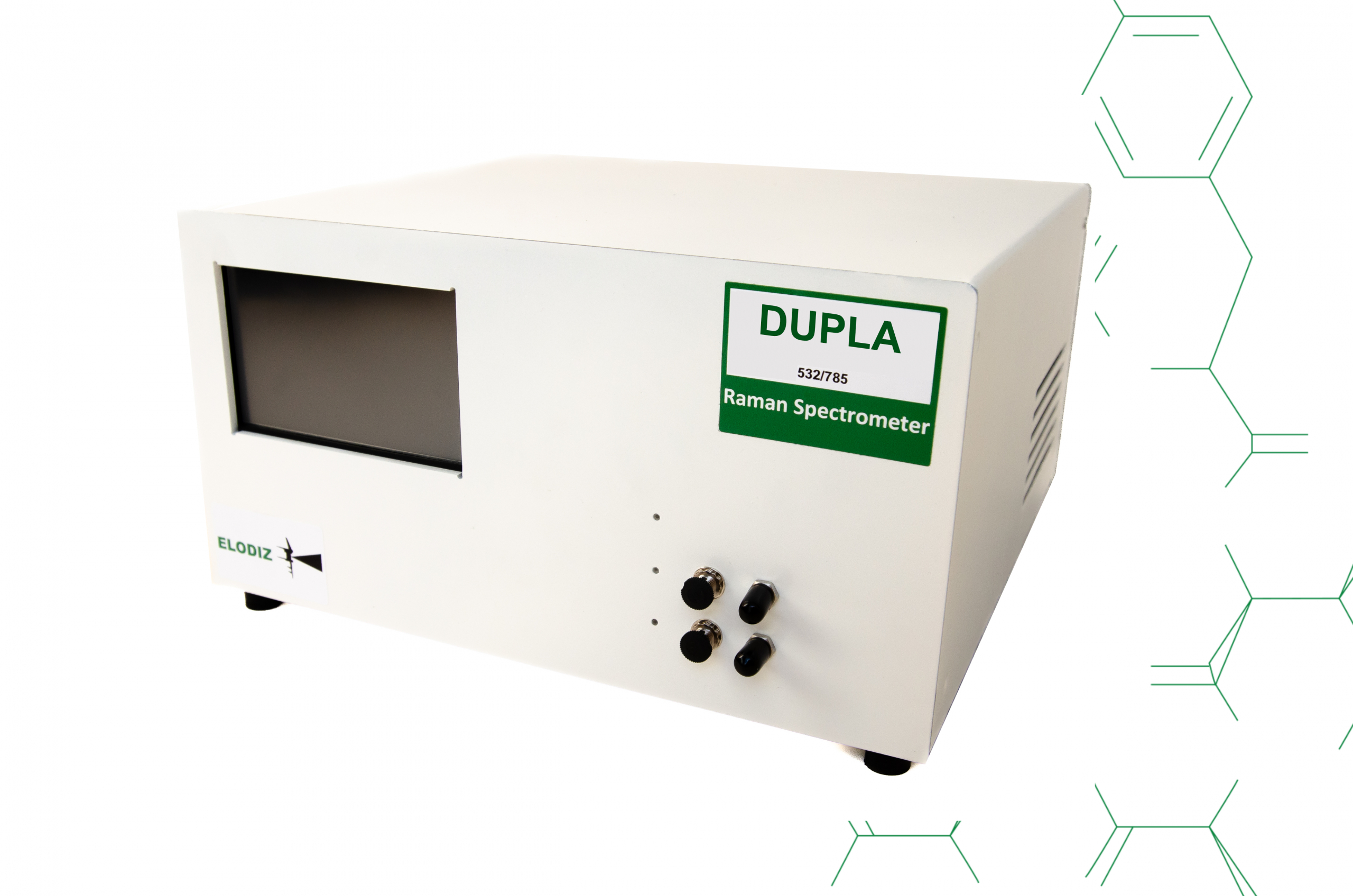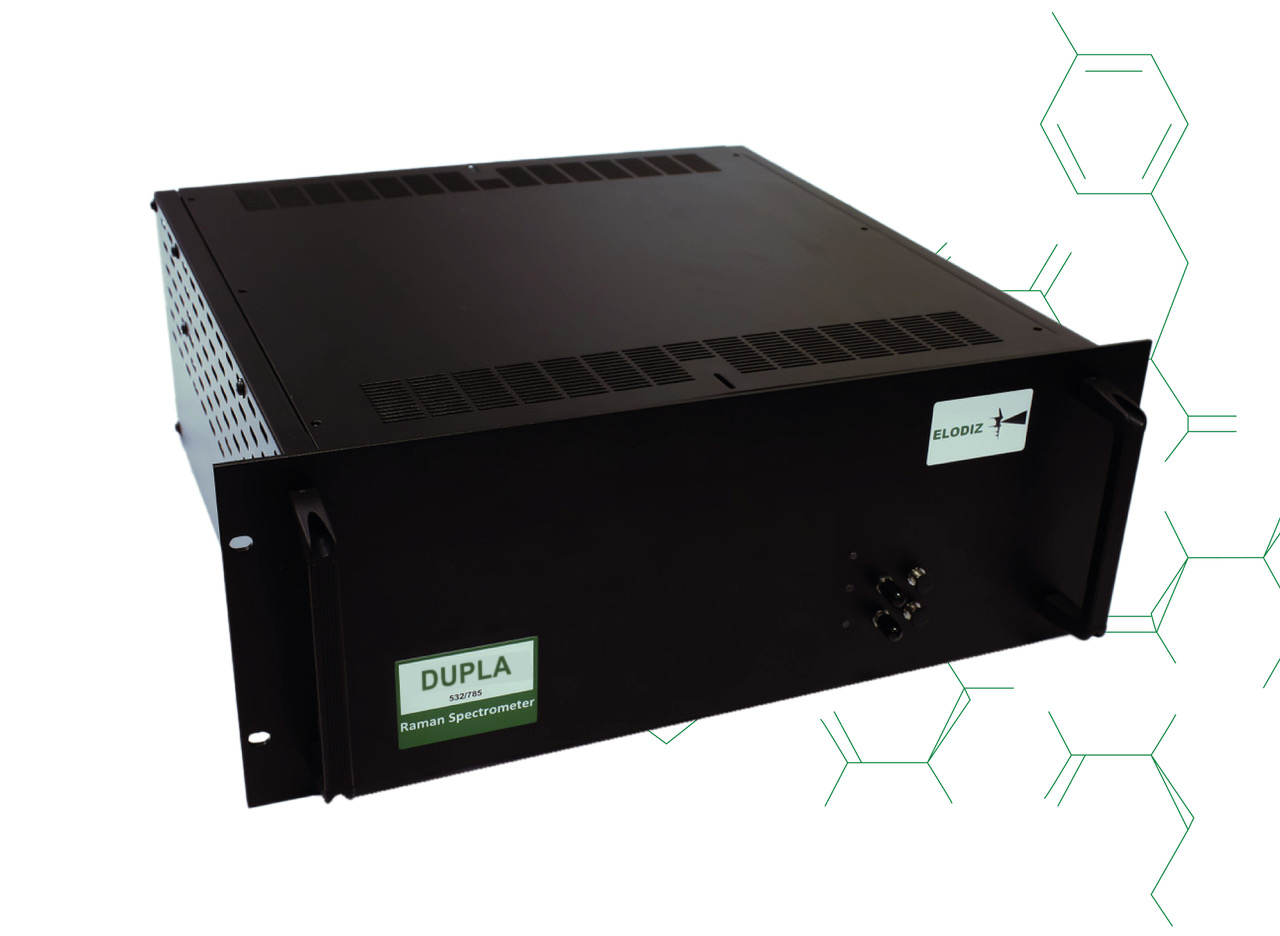The benefits of multichannel Raman spectroscopy in art conservation
by Dr Enrique Lozano
Overview
Raman spectroscopy is a powerful analytical technique that in recent years has gained significant recognition in the field of art conservation and that is being utilised by numerous institutions worldwide, helping to advance research, authentication and preservation efforts.
According to scientific paper references or as indicated on their websites, many prominent museums and research institutions have incorporated Raman spectroscopy into their analytical toolkit, mostly in collaboration with high-end microscopes, and in recent years also reaching for portable Raman devices (hence our interest in presenting this 😊).
The institutions include museums in the UK (British, Natural History, V&A), institutions in the USA (The Getty Conservation Institute, The National Gallery of Art, The Metropolitan Museum of Art, The Art institute of Chicago, The J. Paul Getty Museum) and other countries like France (The Louvre) or the Netherlands (The Rijksmuseum).
Additionally, various independent conservation bodies and research institutes specialising in art conservation employ Raman spectroscopy as a standard technique in their work. These organisations often contribute to conservation research by collaborating with museums and heritage institutions and providing them with analytical services.
It’s worth noting that the adoption of Raman spectroscopy can vary among institutions based on factors such as research focus, available resources, and regional preferences. Raman spectroscopy is still a relatively expensive technology in the area of high end microscopes, but the introduction of affordable, portable devices like ELODIZ NEEGALA, is helping to expand the userbase. Some organisations may have dedicated conservation science departments that extensively utilise Raman spectroscopy and other analytical techniques, while others may collaborate with external research partners for specific projects.
The benefits of Raman spectroscopy in art conservation
The expansion of Raman spectroscopy usage in the conservation area is understandable when we consider its benefits, many of which can apply to other research areas:
1. Non-contact, non-destructive analysis: One of the primary advantages of Raman spectroscopy is its non-contact, non-destructive nature (laser damage of the sample is a permanent possibility in any Raman analysis; because of the nature of the analysed objects, extra precautions are always carried out as explained further down the app note text). It allows for the analysis of artwork from a safe distance and without causing any damage or alteration to the object. This is particularly important when dealing with delicate and valuable artefacts.
2. Identification of materials: Raman spectroscopy is a fingerprint technique that can identify the chemical composition of various materials present in artwork, including pigments, binders, varnishes, coatings, and, in some cases, contaminants. By analysing the unique molecular vibrations signature of different compounds, Raman spectroscopy provides a fingerprint-like spectrum that can be compared to reference databases for identification. For identification purposes, a comprehensive database is required. We will briefly describe how to create one further down this application note.
3. Differentiation of materials: In art conservation, it is crucial to distinguish between original materials and later additions or alterations. Raman spectroscopy can help in this regard by differentiating between different types of pigments, dyes, and other materials. It can provide insights into the authenticity and integrity of the artwork*.
4. Monitoring degradation and ageing: Artwork can undergo chemical and physical changes over time due to various factors like light exposure, humidity and pollutants. Raman spectroscopy can detect and monitor these changes by analysing molecular alterations, such as pigment degradation, polymer ageing, or varnish deterioration. This information can assist conservators in devising appropriate preservation and restoration strategies.
5. Characterisation of binding media: Raman spectroscopy can be used to identify and characterise binding media, such as resins, oils, waxes, or natural gums, used in the creation of artwork. Understanding the composition of these materials helps conservators in formulating appropriate cleaning and consolidation methods, as well as selecting compatible conservation treatments.
6. Detection of forgeries and alterations: Raman spectroscopy can aid in the identification of forgeries or alterations in artwork. By analysing the chemical composition of pigments and other materials, it can reveal inconsistencies or anachronistic components that may indicate fraudulent or modified artwork.
7. Conservation decision-making: Raman spectroscopy provides conservators with valuable information for making informed decisions about treatment strategies. It assists in selecting appropriate cleaning solvents, consolidation materials, and adhesives based on chemical compatibility with the artwork’s components.
Overall, Raman spectroscopy plays a crucial role in art conservation and restoration by offering non-destructive, precise, and reliable analysis of materials. It helps in understanding the composition, condition, and history of artworks and restorations, enabling conservators to preserve and restore them effectively while maintaining their artistic and historical integrity. With such broad application the benefits of Raman spectroscopy in art conservation are very clear, however, based on literature, it appears that some individuals and research groups disagree on what laser line or setup (microscopes, fibre-optic probes, remote sensing) is the most suitable when using this technology in the field of art. The choice of these parameters depends on various factors, including the specific artwork or material under investigation, the desired analytical depth, and the available equipment. At ELODIZ we have tried to address these needs by introducing a flexible device with multiple configurations based around fibre-optic arrangements.
Considerations for use of Raman spectroscopy in art conservation
Here are some considerations related to laser lines, setups, and instrumentation in Raman spectroscopy for art conservation:
1. Laser lines: Raman spectroscopy typically uses lasers with different wavelengths, such as 532 nm, 785 nm, (and 1064 nm, this one should be used with strong care, as the laser power and nature of NIR radiation, can cause damage to some samples). The choice of laser line depends on the nature of the samples being analysed. Shorter wavelengths, like 532 nm, are suitable for analysing samples without strong fluorescence, while longer wavelengths, like 785 nm (or 1064 nm), are preferred for more light-sensitive samples or samples with fluorescence. It is important to consider the potential interactions between the laser wavelength and the materials in the artwork to avoid any damage or alteration.
2. Microscopes and fibre-optic probes: Raman spectroscopy can be performed using microscope-based systems or fibre-optic probes. Microscope-based setups offer higher spatial resolution and are suitable for analysing small areas or specific features of an artwork. Fibre-optic probes, on the other hand, allow for remote measurements and can be more flexible in terms of sample accessibility. The choice between the two depends on the specific requirements of the analysis and the size and condition of the artwork.
3. Remote sensing (fibre-optics setups or long distance open optics like tele-objectives): Remote Raman spectroscopy is a technique that allows for non-contact analysis of artwork from a distance (from mm to meters!). It is particularly useful for large or fragile objects that cannot be easily moved or sampled. Remote sensing setups use specialised optics to collect Raman scattered light from the artwork. However, this approach may have limitations in terms of spatial resolution and sensitivity compared to direct contact measurements. Special attention must be given to avoid any potential damage. Sometimes these types of setups are associated with some remote-operation positioning devices.
4. Instrumentation considerations: The choice of instrumentation depends on the specific needs of the art conservation application. Factors such as sensitivity, spectral resolution, and signal-to-noise ratio are important considerations. High-quality detectors and spectrometers with appropriate resolution are crucial for obtaining accurate and detailed Raman spectra. Additionally, the availability of appropriate sample holders or stages to ensure stability and proper positioning of the artwork during analysis is important. It should be clear to all users, that the analysis of a small part of a painting at a microscopic level is not the same as analysing what type of mineral or stone was used to build or restore a piece of art.
While there may not be a consensus on the optimal laser line, setup, or instrumentation for every situation, it is essential to consider the specific requirements and constraints of the artwork and the research objectives. Collaboration and communication among researchers, conservators, and scientists with expertise in Raman spectroscopy can help in selecting the most appropriate setup and methodology for each conservation project.
ELODIZ instruments in art conservation projects
ELODIZ in collaboration with the Fitzwilliam Museum, the art and antiques museum of the University of Cambridge (UK) run some tests to evaluate ELODIZ NEEGALA Raman device in the art research field. The NEEGALA Raman spectrometer equipped with a 532 nm and a 785 nm laser was used to analyse a series of mock-up samples made at the Fitzwilliam Museum and consisting of historical pigments bound in tempera or gum Arabic.
Samples were analysed with the 532 nm and the 785 nm channels. Most of the blue and/or green pigment samples analysed were read without any problem for both channels. The 532 nm channel was preferred for these pigments, as the readout time was shorter for a better signal to noise ratio. However the orange and/or red pigment samples analysed, exhibited a strong fluorescence when analysed using the 532 nm channel. When utilising the 785 nm channel, the instrument performed efficiently on orange and red pigments, in particular red lead and vermilion. In cases of lead-based pigments, the laser power had to be increased to 5% to obtain a spectrum with a good signal-to-noise ratio, whereas, on the vermilion sample, a laser power of 1% was enough to produce all the characteristic peaks of the pigment.
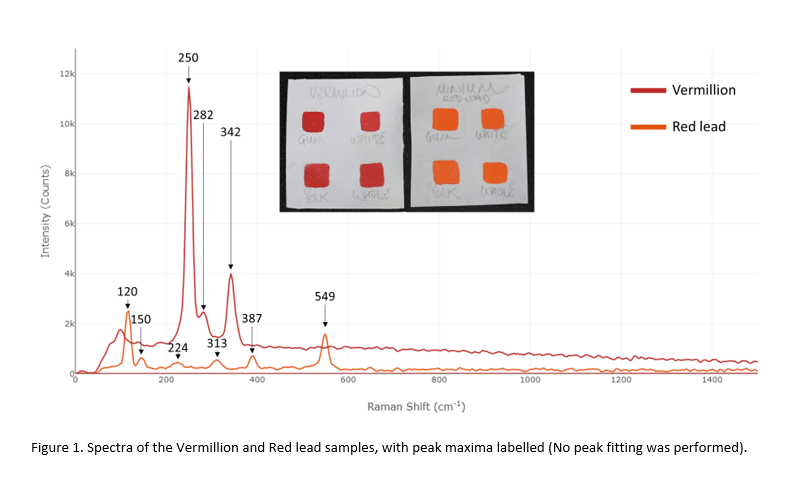
A white sample containing a mixture of lead white and titanium white (rutile form) was analysed and the peaks of the two white pigments were detected. It transpired that the broad peak of lead white at about 100 cm-1 might interfere with pigments that show peaks in the first portion of the spectrum.
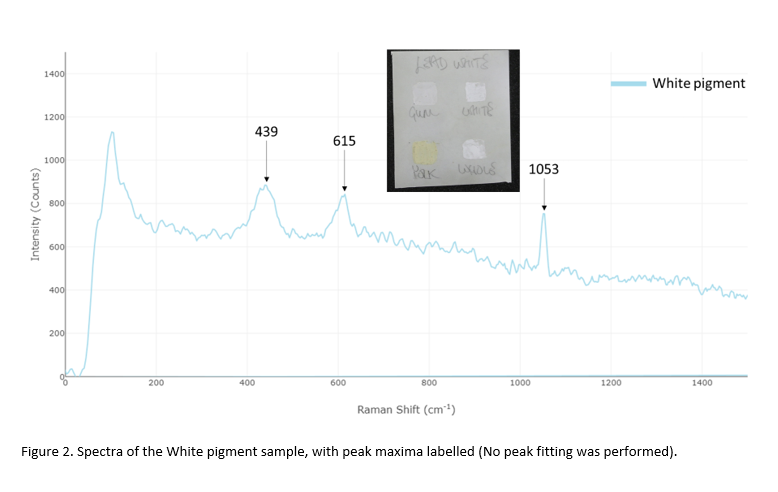
The equipment was finally tested on a yellow sample made of yellow ochre and gum Arabic. Despite the extension of the analysis time and the use of higher laser power, the spectrum had a low signal-to-noise ratio and some of the characteristic peaks could not be distinguished as per literature references. However, we were able to observe the peaks as described in the literature.
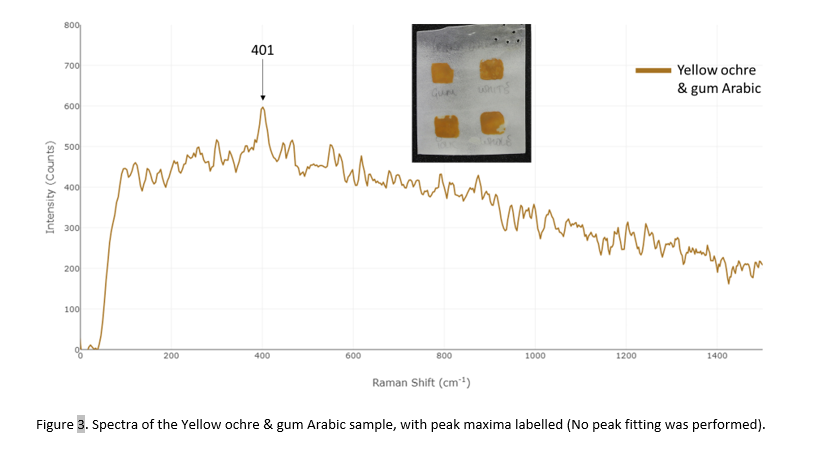
The Fitzwilliam Museum paint their reference samples with the main aim of creating a database (useful for comparison with objects made of complex mixtures). The below samples have been used for FORS analysis, as different binders and substrate, which is parchment in this case, can affect the result. Most common binders used in the Middle Ages, and on manuscripts were chosen because the museum’s work focused on those objects. Figure 4 shows examples of different mixtures that can be used to turn the pigment into paint, e.g. lead white; Gum: gum Arabic: White: egg white; Yolk: egg yolk; whole: whole egg.
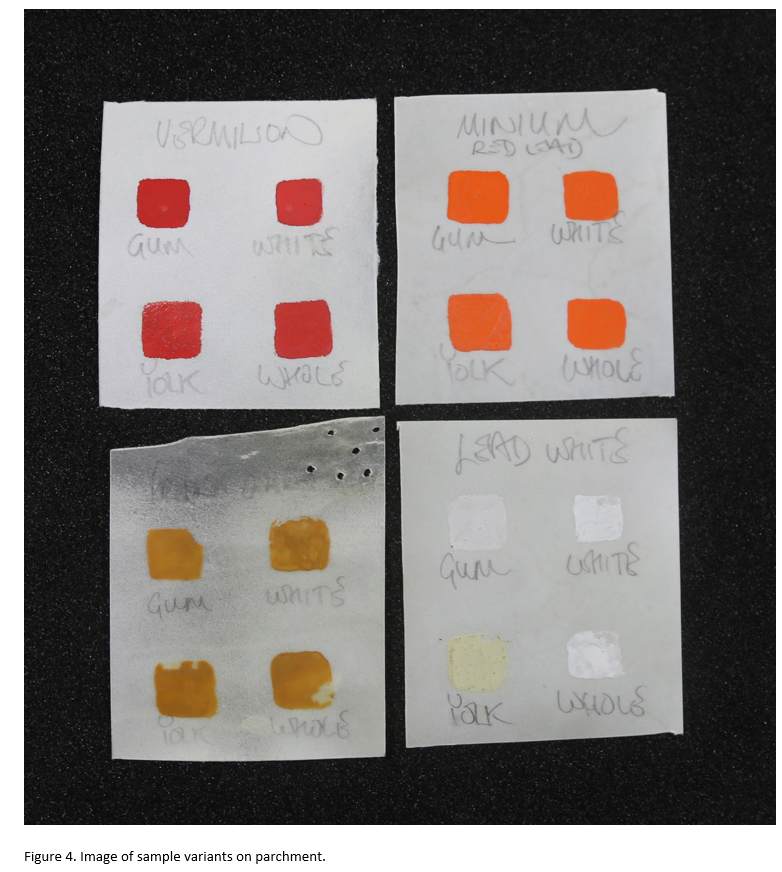
When performing the test, we followed “best practice on using laser technology in art”, i.e. we were aware that Raman technology should not be used directly on the tested object, unless the safety of the piece of equipment is guaranteed. Hence the use of reference samples. Analysis should always start with the lowest possible laser level and photos taken alongside to see if any laser damage is possible (cameras may be superior to the naked eye here, to pick up on any yellowing due to local overheating). This way you can test the limits of the laser power and the amount of time and see what happens (worst case scenario you burn a reference sample that can be re-made, and not a priceless object) which would be particularly helpful for users who don’t have a great experience with Raman. Always start at lowest possible laser power and increase it in small percentages to assure no damage and good signal-to-noise ratio. Take your time, rushing in conservation is never a good idea.
Raman reference databases of pigments have been published at least twenty to thirty years ago**, especially for historical pigments like the ones that were tested, however, it may be easier to have your own database instead of comparing the spectrum with an online paper. This is logically a personal decision of the researcher. It is always worth comparing existing international references with local ones.
Conclusion
ELODIZ NEEGALA dual channel (532/785 nm) has proved to be a versatile and valuable tool for the research in the art and conservation area. The advantage of being able to combine complementary line sources in a single device allows more flexibility than individual monochromatic systems. Some pigments and materials are more suited for analysis with the 532 nm line while others are more suited for the 785 nm line.
For further information contact us at: info@elodiz.com
References
** Suggested reference sites for Raman databases:
https://chsopensource.org/pigments-checker/
http://www.irug.org/search-spectral-database/spectra-index?sortHeader=data_type_raman
https://rruff.info


